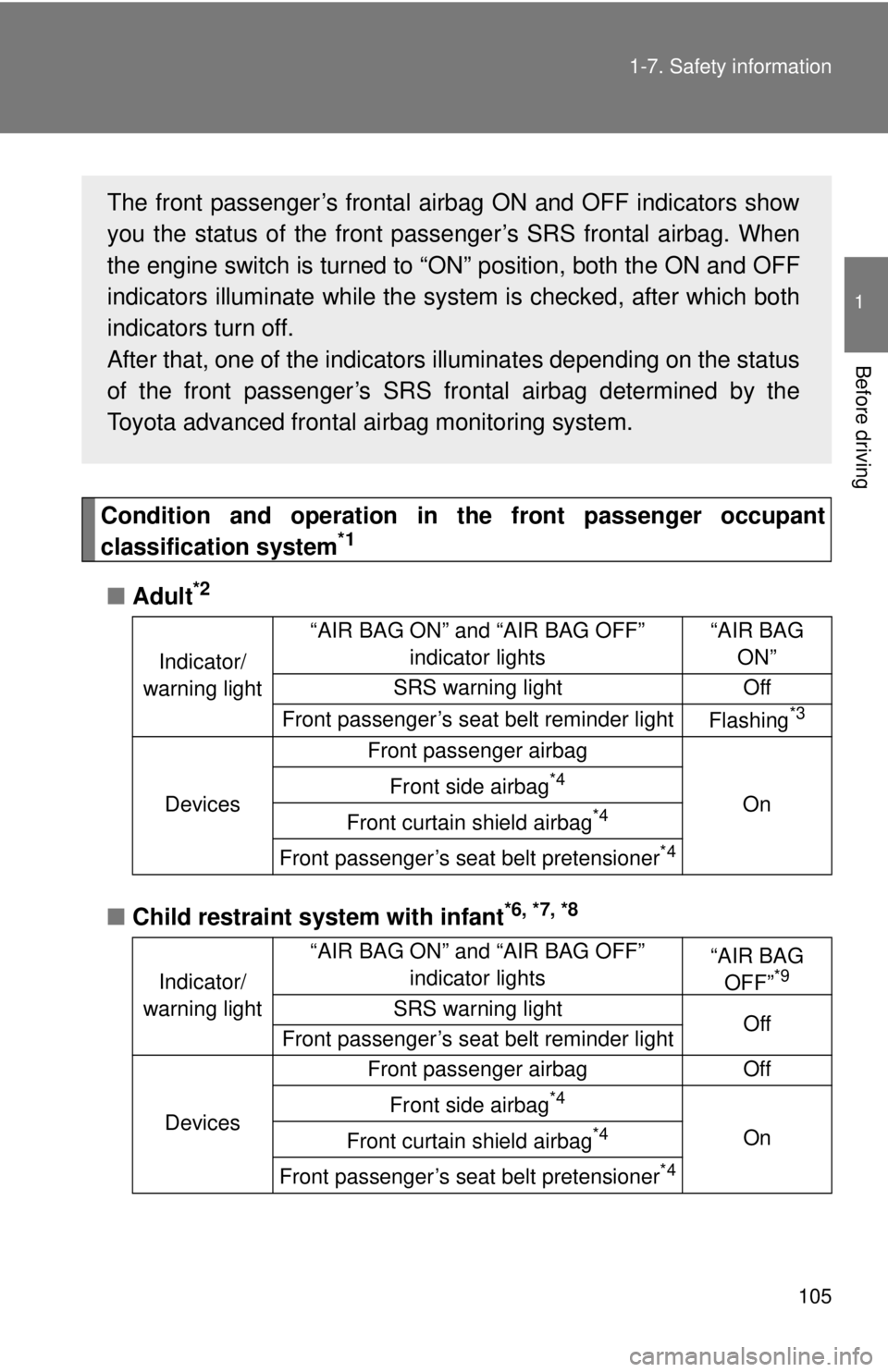2017 TOYOTA 86 check engine
[x] Cancel search: check enginePage 4 of 428

TABLE OF CONTENTS Index
44-3. Do-it-yourself
maintenance
Do-it-yourself service
precautions ...................... 250
Hood................................... 253
Positioning a floor jack ....... 255
Engine compartment .......... 257
Tires ................................... 270
Tire inflation pressure......... 277
Wheels ............................... 281
Air conditioning filter ........... 284
Wireless remote control
key battery ....................... 287
Checking and replacing
fuses ................................ 290
Light bulbs .......................... 298
5-1. Essential information
Emergency flashers ........... 306
If your vehicle needs to be
towed ............................... 307
If you think something is
wrong ............................... 315
Fuel pump shut off
system .............................. 316 5-2. Steps to take in an
emergency
If a warning light turns
on or a warning buzzer
sounds... .......................... 317
If you have a flat tire ........... 327
If the engine will not
start .................................. 338
If the shift lever cannot be
shifted from P ................... 339
If you lose your keys ........... 340
If the battery is
discharged ........................ 341
If your vehicle overheats..... 345
If the vehicle becomes
stuck ................................. 348
If your vehicle has to be
stopped in an
emergency........................ 350
6-1. Specifications
Maintenance data
(fuel, oil level, etc.) ........... 354
Fuel information .................. 366
Tire information................... 370
6-2. Customization
Customizable features ........ 3835
When trouble arises 6
Vehicle specifications
Page 15 of 428

15For your information Main Owner’s Manual Please note that this manual applies to all models and explains all equip-
ment, including options. Therefore, you may find some explanations for
equipment not installed on your vehicle.
All specifications provided in this manual are current at the time of printing.
However, because of the Toyota policy of continual product improvement, we
reserve the right to make changes at any time without notice.
Depending on specifications, the vehicle shown in the illustration may differ
from your vehicle in terms of color and equipment.
Noise from under vehicle after turning off the engine Approximately five to ten hours after the engine is turned off, you may hear
sound coming from under the vehicle for several minutes. This is the sound
of a fuel evaporation leakage check and, it does not indicate a malfunction.
Accessories, spare parts and modification of your Toyota A wide variety of non-genuine spare parts and accessories for Toyota vehi-
cles are currently available in the market. You should know that Toyota does
not warrant these products and is not responsible for their performance,
repair, or replacement, or for any damage they may cause to, or adverse
effect they may have on, your Toyota vehicle.
This vehicle should not be modified with non-genuine Toyota products. Mod-
ification with non-genuine Toyota products could affect its performance,
safety or durability, and may even violate governmental regulations. In addi-
tion, damage or performance problems resulting from the modification may
not be covered under warranty.
Page 56 of 428

561-4. Opening and closing the windows
WARNING■ Closing the windows
Observe the following precautions.
Failure to do so may result in death or serious injury.
● The driver is responsible for all the power window operations, including the
operation for the passengers. In order to prevent accidental operation,
especially by a child, do not let a child operate the power windows. It is
possible for children and other passengers to have body parts caught in
the power window. Also, when riding with a child, it is recommended to use
the window lock switch. ( → P. 54)
● Check to make sure that all passengers do not have any part of their body
in a position where it could be caught when a window is being operated.
● When exiting the vehicle, turn the engine switch off, carry the key and exit
the vehicle along with the child. There may be accidental operation, due to
mischief, etc., that may possibly lead to an accident.
■ Jam protection function
● Never use any part of your body to intentionally activate the jam protection
function.
● The jam protection function may not work if something gets caught just
before the window fully closes.
Page 79 of 428

791-7. Safety information
1
Before driving ■ If the passenger’s frontal airbag OFF indicator illum inates and the ON
indicator turns off even when the fr ont passenger’s seat is occupied by
an adult
This can be caused by the adult incorrectly sitting in the front passenger’s
seat. Turn the engine switch to the “LOCK” position. Ask the front passenger
to set the seatback to the upright position, sit up straight in the center of the
seat cushion, correctly fasten the seat belt, position his/her legs out forward,
and adjust the seat to the rearmost position. Turn the engine switch to the
“ON” position. If the OFF indicator remains illuminated while the ON indica-
tor remains off, take the following actions.
● Turn the engine switch to the “LOCK” position.
● Make sure that the front passenger does not use a blanket, seat cushion,
seat cover, seat heater or massager, etc.
● If wearing excessive layers of clothing, the front passenger should
remove any unnecessary items before sitting in the front passenger’s
seat, or should sit in a rear seat.
● Next, turn the engine switch to the “ON” position and wait 6 seconds to
allow the system to complete self-checking. Following the system check,
both indicators turn off for 2 seconds. Now, the ON indicator should illu-
minate while the OFF indicator remains off.
If the OFF indicator still remains illuminated while the ON indicator remains
off, ask the occupant to move to the rear seat and immediately contact your
Toyota dealer for an inspection.
Page 103 of 428

1031-7. Safety information
1
Before driving ● Curtain shield airbag module (left-hand side)
● Satellite safing sensor (under the center of the rear seats)
● Seat belt pretensioner (driver’s side)
● Seat belt pretensioner (front passenger’s side)
● Seat belt buckle switch (front passenger’s side)
● Front passenger’s occupant classification system sensor
● Front passenger’s occupant detection control module
● Front passenger’s frontal airbag ON and OFF indicator
● All related wiring
WARNING■ SRS warning light
If the warning light exhibits any of the following conditions, there may be a
malfunction in the seat belt pretensioners, SRS airbag system and/or front
passenger occupant classification system. Immediately take your vehicle to
your nearest Toyota dealer to have the system checked. Unless checked
and properly repaired, the seat belt pretensioners, SRS airbag and/or front
passenger occupant classification system will not operate properly in the
event of a collision, which may increase the risk of death or serious injury.
● Flashing or flickering of the warning light
● No illumination of the warning light when the engine switch is first turned to
the “ON” position.
● Continuous illumination of the warning light
● Illumination of the warning light while driving
Page 105 of 428

1051-7. Safety information
1
Before driving
Condition and operation in th e front passenger occupant
classification system *1
■ Adult *2
■ Child restraint system with infant *6, *7, *8Indicator/
warning light “AIR BAG ON” and “AIR BAG OFF”
indicator lights “AIR BAG
ON”
SRS warning light Off
Front passenger’s seat belt reminder light
Flashing *3
Devices Front passenger airbag
OnFront side airbag *4
Front curtain shield airbag *4
Front passenger’s seat belt pretensioner *4
Indicator/
warning light “AIR BAG ON” and “AIR BAG OFF”
indicator lights “AIR BAG
OFF” *9
SRS warning light
Off
Front passenger’s seat belt reminder light
Devices Front passenger airbag Off
Front side airbag *4
On
Front curtain shield airbag *4
Front passenger’s seat belt pretensioner *4The front passenger’s frontal airbag ON and OFF indicators show
you the status of the front pass enger’s SRS frontal airbag. When
the engine switch is turned to “O N” position, both the ON and OFF
indicators illuminate while the system is checked, after which both
indicators turn off.
After that, one of the indicators illuminates depending on the status
of the front passenger’s SRS fr ontal airbag determined by the
Toyota advanced frontal ai rbag monitoring system.
Page 108 of 428

1081-7. Safety information
If the passenger’s frontal airbag OFF indicator illuminates and the ON indicator
turns off even when the front passenger’s seat is occupied by an adult
This can be caused by an adult in correctly sitting in the front passen-
ger’s seat. Perform the following.
The engine switch is turned to the “LOCK” position.
Ask the front passenger to set the seatback to the upright
position, sit up straight in the ce nter of the seat cushion, cor-
rectly wear the seat belt, posit ion his/her legs out forward, and
adjust the seat to the rearmost position.
The engine switch is turned to the “ON” position.
If the OFF indicator remains illuminated while the ON indicator
remains off, perform the following.
• The engine switch is turned to the “LOCK” position.
• Make sure that the front passenger is not using a blanket,
seat cushion, seat cover or seat heater, etc.
• If wearing excessive layers of clothing, the front passenger
should remove any unnecessary items before sitting in the
front passenger seat, or should sit in a rear seat.
The engine switch is turned to the “ON” position. After the
self-check is performed, the ON indicator should illuminate
while the OFF indicator remains off. If the OFF indicator still
remains illuminated while the ON indicator remains off, ask
the occupant to move to the rear seat and immediately con-
tact your Toyota dealer for an inspection.STEP 1
STEP 2
STEP 3
STEP 4
STEP 5
Page 133 of 428

1332-1. Driving procedures
2
When driving WARNING■ When driving the vehicle
● Do not drive if you are unfamiliar with the location of the brake and accel-
erator pedals to avoid depressing the wrong pedal.
• Accidentally depressing the accelerator pedal instead of the brake
pedal will result in sudden acceleration that may lead to an accident
that could result in death or serious injury.
• When backing up, you may twist your body around, leading to a diffi-
culty in operating the pedals. Make sure to operate the pedals properly.
• Make sure to keep a correct driving posture even when moving the
vehicle only slightly. This allows you to depress the brake and acceler-
ator pedals properly.
• Depress the brake pedal using your right foot. Depressing the brake
pedal using your left foot may delay response in an emergency, result-
ing in an accident.
● Do not drive the vehicle over or stop the vehicle near flammable materials.
The exhaust system and exhaust gases can be extremely hot. These hot
parts may cause a fire if there is any flammable material nearby.
● On vehicles with an automatic transmission, do not let the vehicle roll
backward while the shift lever is in a driving position, or roll forward while
the shift lever is in R.
Doing so may cause the engine to stall or lead to poor brake and steering
performance, resulting in an accident or damage to the vehicle.
● If the smell of exhaust is noticed inside the vehicle, open the windows and
check that the trunk is closed. Large amounts of exhaust in the vehicle can
cause driver drowsiness and an accident, resulting in death or a serious
health hazard. Have the vehicle inspected by your Toyota dealer immedi-
ately.
● On vehicles with a manual transmission, do not shift the shift lever to R
while the vehicle is moving forward.
Doing so can damage the transmission and may result in a loss of vehicle
control.
● Do not shift the shift lever to a driving position while the vehicle is moving
backward.
Doing so can damage the transmission and may result in a loss of vehicle
control.